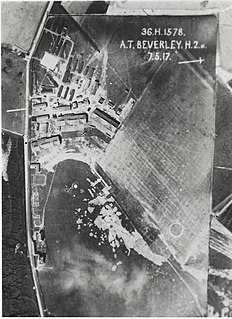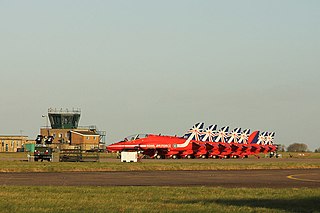 W
WRAF Bacton is a former Royal Air Force landing field, built to accommodate aircraft intercepting Zeppelin bombers during the First World War.
 W
WBeverley Aerodrome, was a First World War era Royal Flying Corps training depot, in Bishop Burton, East Riding of Yorkshire, England. The site, like many others in Yorkshire, was developed from a racecourse on the western edge of Beverley, along the road between Beverley and York. Initially set up as a location for squadrons employed in Home Defence (HD), particularly preventing Zeppelin attacks on Hull and the east coast, the site later became a training depot for squadrons and flights who would then deploy to the front line. Beverley was also used as a standing up and transfer location for six Canadian Reserve Squadrons in 1917, all of which were posted to Canada. Beverley Aerodrome was used between 1916 and 1920, with the RAF later using the site in the 1930s in a non-flying role.
 W
WBramham Moor Aerodrome,, was a First World War era military airfield near to the village of Bramham, West Yorkshire, England. Initially a Royal Flying Corps site, on the formation of the RAF, its name was officially changed to RAF Tadcaster, however, the unit was still referred to as Bramham, or Bramham Moor, even in official documents. The base was used between March 1916 and December 1919 by active aircraft squadrons, but was not closed down until April 1920. Bramham was originally used as a Home Defence station, due to the threat of Zeppelin attacks, but later, it was used primarily for preparing aircrew for front line operations. It did not see re-use as an airfield during the Second World War, however, vehicles were parked on the grassed runway areas to deter glider landings during the threat of invasion.
 W
WChalfont Park, formerly known as Brudenells and Bulstrodes, is an English country house and estate near the village of Chalfont St Peter in Buckinghamshire.
 W
WRoyal Air Force Driffield or RAF Driffield is a former Royal Air Force station in the East Riding of Yorkshire, in England. It lies about 2 miles (3 km) south-west of Driffield and 11 miles (18 km) north-west of Beverley. It is now operated by the Defence Infrastructure Organisation, as the Driffield Training Area.
 W
WDuxford Aerodrome is located 8 nautical miles south of Cambridge, within the Parish of Duxford, Cambridgeshire, England and nearly 1-mile (1.6 km) west of the village.
 W
WRoyal Air Force Felixstowe, or more simply RAF Felixstowe, is a former Royal Air Force station located 2.7 miles (4.3 km) northeast of Harwich, Essex, England and 10.7 miles (17.2 km) southeast of Ipswich, Suffolk.
 W
WFowlmere Airfield is a small airfield located 4.2 miles (6.8 km) northeast of Royston, Hertfordshire and 8.8 miles (14.2 km) southwest of Cambridge, Cambridgeshire, England. It was previously a Royal Air Force station, RAF Fowlmere.
 W
WRNAS Hornsea Mere,, was a Royal Navy Air Service seaplane base located on Hornsea Mere, in the East Riding of Yorkshire, England. The mere was utilised for seaplane due to its proximity to the sea, but additionally, its still water which made it easier to launch the planes. Initially used as a relief site, the base became a full station in 1918, and was vacated in 1919. many of the original buildings and earthworks survive into the modern day.
 W
WThe Humber Forts are two large fortifications in the mouth of the Humber Estuary in northern England: Haile Sand Fort and Bull Sand Fort.
 W
WLeadenham Aerodrome was a Royal Flying Corps First World War airfield at Leadenham, Lincolnshire, England. It became RAF Leadenham in April 1918 until it closed in 1919.
 W
WRoyal Air Force Manywells Height was a grassed airstrip in use as Home Defence during the First World War. The site was just south of the village of Cullingworth which is south of Keighley and north west of Bradford in West Yorkshire.
 W
WMarske Aerodrome was a First World War-era airfield used by the Royal Flying Corps, and later by the Royal Air Force, between 1917 and 1920. The aerodrome was just to the east of the village of Marske-by-the-Sea in North Yorkshire, England. Marske aerodrome hosted air gunnery schools and trained pilots in tactics and methods of aerial combat so that they could be deployed to the front. Marske is known for being the aerodrome where W. E. Johns, author of the Biggles books, undertook his training, as well as being noted for some of the flying instructors who were famous among the aircrew cadre.
 W
WRedcar Aerodrome is a former First World War airfield located in Redcar, North Yorkshire, England. The site hosted an elementary flying school for newly entered pilots into the Royal Naval Air Service, though some offensive and defensive operations were flown from Redcar as well. The base was created as part of chain of new air stations after the German naval bombardment of east coast towns in December 1914. The base had a brief operational lifespan between July 1915 and December 1919, after which it was decided not to retain Redcar as an active station, and much of the site has been re-used for housing.
 W
WRoyal Air Force Ripon was a First World War airfield maintained by the Royal Flying Corps in the city of Ripon, North Yorkshire, England. The airfield was home to No. 76 Squadron which was employed on Home Defence (HD) in the United Kingdom. The airfield was created when the Royal Flying Corps (RFC) commandeered the southern half of Ripon Racecourse in 1916. After the end of the First World War, the airfield was returned to horse-racing.
 W
WRoyal Air Force Scampton or RAF Scampton is a Royal Air Force station located adjacent to the A15 road near to the village of Scampton, Lincolnshire, and 6 miles (9.7 km) north west of the city, Lincoln, England.
 W
WThe Spurn Point Military Railway was a railway line in the East Riding of Yorkshire, England. It extended for 3+3⁄4 miles (6 km), connecting Kilnsea with Spurn Point in the Humber Estuary. The line was built to supply military installations along this stretch of coast.
 W
WStow Maries Aerodrome is a historical airfield located in the village of Stow Maries, Essex, England. The airfield was in use by the Royal Flying Corps during the First World War. It has been given listed status on account of being the best preserved airfield complete with First World War era buildings and is open to the public as a visitor attraction.
 W
WRoyal Air Force Station Wormingford is a former Royal Air Force station located 6 miles (9.7 km) northwest of Colchester, Essex, England.